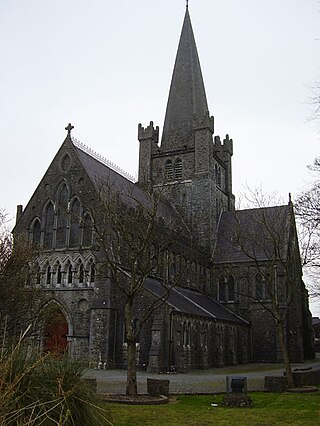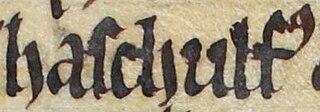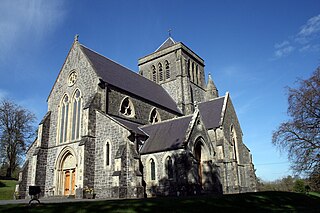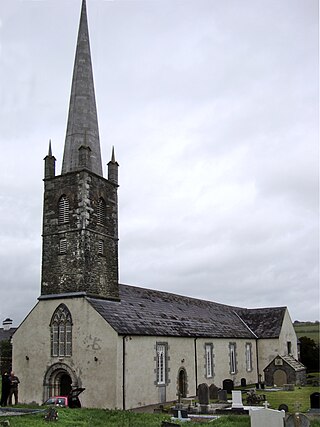Related Research Articles

The Archbishop of Tuam is an archbishop which takes its name after the town of Tuam in County Galway, Ireland. The title was used by the Church of Ireland until 1839, and is still in use by the Catholic Church.

The Bishop of Ardagh was a separate episcopal title which took its name after the village of Ardagh, County Longford in Ireland. It was used by the Roman Catholic Church until 1756, and intermittently by the Church of Ireland until 1839.
Events from the year 1224 in Ireland.

Ascall mac Ragnaill meic Torcaill, also known as Ascall Mac Torcaill, was the last Norse-Gaelic king of Dublin. He was a member of the Meic Torcaill, a Dublin family of significance since the early twelfth century.

The Bishop of Kilmore is an episcopal title which takes its name after the parish of Kilmore, County Cavan in Ireland. In the Roman Catholic Church it remains a separate title, but in the Church of Ireland it has been united with other bishoprics.
Events from the year 1542 in Ireland.

The Bishop of Ross was a separate episcopal title which took its name after the town of Rosscarbery in County Cork, Ireland. The title is now united with other bishoprics. In the Church of Ireland it is held by the Bishop of Cork, Cloyne and Ross, and in the Roman Catholic Church it is held by the Bishop of Cork and Ross.

The Bishop of Elphin is an episcopal title which takes its name after the village of Elphin, County Roscommon, Ireland. In the Roman Catholic Church it remains a separate title, but in the Church of Ireland it has been united with other bishoprics.
Roland de Burgo was an Irish Church of Ireland cleric who was Dean of Clonfert, Bishop of Clonfert (1534–1580) and Bishop of Elphin (1551–1580).
Bernard O'Gara was an Irish clergyman who served as the Roman Catholic Archbishop of Tuam from 1723 to 1740. O'Gara was the grandson of Fearghal Ó Gadhra.

Gofraid mac Amlaíb meic Ragnaill was a late eleventh-century King of Dublin. Although the precise identities of his father and grandfather are uncertain, Gofraid was probably a kinsman of his royal predecessor, Echmarcach mac Ragnaill, King of Dublin and the Isles. Gofraid lived in an era when control of the Kingdom of Dublin was fought over by competing Irish overlords. In 1052, for example, Echmarcach was forced from the kingdom by the Uí Chennselaig King of Leinster, Diarmait mac Maíl na mBó. When the latter died in 1072, Dublin was seized by the Uí Briain King of Munster, Toirdelbach Ua Briain, a man who either handed the Dublin kingship over to Gofraid, or at least consented to Gofraid's local rule.
Richard Brady, O.F.M. was an Irish prelate of the Roman Catholic Church who served as Bishop of Ardagh from 1576 to 1580 and then Bishop of Kilmore from 1580 to 1607.
Patrick Walsh was an Irish prelate who served as the Bishop of Waterford and Lismore from 1551 to 1578.
Robert Howard, D.D. was an Anglican prelate who served in the Church of Ireland as the Bishop of Killala and Achonry (1727–1730) and Bishop of Elphin (1730–1740).

Ragnall mac Torcaill was a twelfth-century Norse-Gaelic magnate who may have been King of Dublin. He was a member of the Meic Torcaill, and may be identical to a member of this family who campaigned in Wales in 1144. Ragnall was slain in 1146, with some sources styling him king in records of his demise. He was the father of at least one son, Ascall, a man who certainly reigned as king.
Domnall mac Taidc was the ruler of the Kingdom of the Isles, the Kingdom of Thomond, and perhaps the Kingdom of Dublin as well. His father was Tadc, son of Toirdelbach Ua Briain, King of Munster, which meant that Domnall was a member of the Meic Taidc, a branch of the Uí Briain. Domnall's mother was Mór, daughter of Echmarcach mac Ragnaill, King of Dublin and the Isles, which may have given Domnall a stake to the kingship of the Isles.
The Meic Torcaill, also known as the Meic Turcaill, the Mac Torcaill dynasty, the Mac Turcaill dynasty, and the Mac Turcaill family, were a leading Norse-Gaelic family in mediaeval Dublin. The kindred produced several eminent men and kings of Dublin before the Norman conquest of the kingdom in 1170. Afterwards the family fell from prominence, losing possession of their extensive lands in the region. In time the Meic Torcaill lost precedence to other Dublin families, such as the Harolds and Archbolds.
Ragnall ua Ímair, also known as Ragnall mac Ragnaill, was an eleventh-century King of Waterford. He appears to have ruled as king from 1022 to 1035, the year of his death.
Charles Reynolds was an Irish Catholic cleric, canonist, and diocesan administrator. Born in County Leitrim into an Irish clan of Hiberno-Norse descent and son of Marcus Mac Raghnaill, Reynolds entered a religious order and was appointed to influential posts as archdeacon and military chaplain to the Earl of Kildare. His name in native Irish is Cathal Mac Raghnaill, but he used the Anglicized name of "Archdeacon Charles Reynolds" whenever he was in the Pale or in the company of English-speakers. He was educated at the University of Oxford and was multilingual; being fluent in English, Irish, and Ecclesiastical Latin. Archdeacon Reynolds opposed Henry VIII of England's policy of imposing Caesaropapism upon the Catholic Church in his dominions, declined to acknowledge him as Supreme Head of the Church of England, and refusing to acknowledge the annulment of the King's marriage to Catherine of Aragon or his uncanonical remarriage to Anne Boleyn.
Thomas Chester was an Irish Anglican bishop in the penultimate decade of the sixteenth century (1580s). The son of William Chester Lord Mayor of London, he was Bishop of Elphin from 1580 until 1583.His elder brother was the first Chester baronet.
References
- ↑ Fryde, E. B.; Greenway, D. E.; Porter, S.; Roy, I., eds. (1986). Handbook of British Chronology (3rd, reprinted 2003 ed.). Cambridge: Cambridge University Press. ISBN 0-521-56350-X.
- ↑ Moody, T. W.; Martin, F. X.; Byrne, F. J., eds. (1984). Maps, Genealogies, Lists: A Companion to Irish History, Part II. A New History of Ireland. Vol. IX. Oxford: Oxford University Press. ISBN 0-19-821745-5.
- ↑ "A Viceroy's Vindication?: Sir Henry Sidney's Memoir of Service in Ireland" Brady, C. (Ed) p125: Cork, Cork University Press, 2002 ISBN 1859181805
- ↑ "Annals of Ireland, Ecclesiastical, Civil and Military" Graham, J. p97: Longon; G.Sidney; 1819
- ↑ Cotton, Henry (1850). The Province of Connaught. Fasti Ecclesiae Hiberniae: The Succession of the Prelates and Members of the Cathedral Bodies of Ireland. Vol. 4. Dublin: Hodges and Smith.
- ↑ "Part 12 of Annals of Loch Cé". Corpus of Electronic Texts. University College Cork.
- ↑ Meigs, Samantha A. (1997). Reformations in Ireland: Tradition and Confessionalism, 1400–1690. Springer. ISBN 978-1-349-25710-2 – via Google Books.